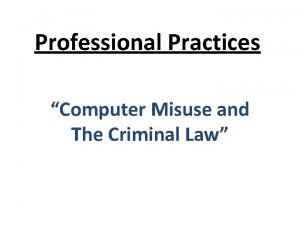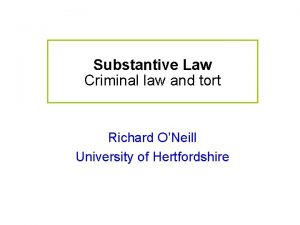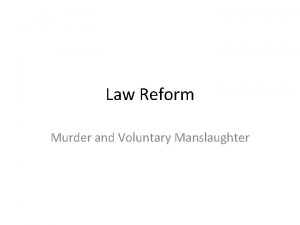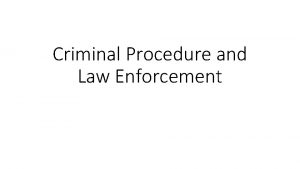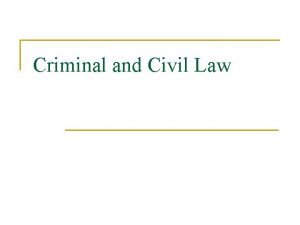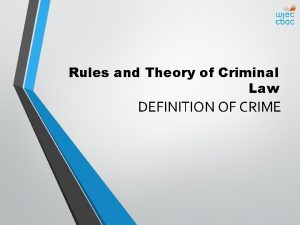Rules of criminal law and theory in criminal















- Slides: 15

Rules of criminal law and theory in criminal law

Aims and Objectives To be able to clearly distinguish the burden and standard of proof between criminal and civil cases. To be able to discuss the issues surrounding the presumption of innocence. To have an understanding of how a defence is raised and argued. To appreciate how law can be codified. To be able to understand discuss how human rights legislation affects our criminal law.

What two aspects need to be present for someone to be convicted of a crime? There also other things to bear in mind – just to complicate the situation for you!

Burden of Proof BURDEN = responsibility. In criminal law, there are two sides – the PROSECUTION and the DEFENCE. The PROSECUTION will have the burden of proving that the defendant is guilty. Sometimes this burden switches to the defendant - the DEFENCE will then need to prove that the defendant has a defence to the crime.

Standard of Proof There are 2 standards of proof ON THE BALANCE OF PROBABILITIES or BEYOND REASONABLE DOUBT ‘Beyond reasonable doubt’ is the standard that is usually used in criminal law – the prosecution needs to prove their case that the defendant is guilty beyond all reasonable doubt.

Standard of Proof ‘Beyond reasonable doubt’ is a very high standard of proof. The judge or jury must be left with hardly a shadow of doubt in their minds that the defendant committed the crime. If not, then the defendant must be found not guilty. Why do you think that such a high standard of proof is required in criminal cases?

Standard of Proof ‘On the balance of probabilities’ = it is more likely than not. This is the standard of proof that is used in civil cases. In criminal cases, it is used when the defendant is claiming certain defences. The burden of proof then switches from the prosecution to the defence but the standard of proof drops to ‘on the balance of probabilities’ which is a lower standard.

Presumption of Innocence This is a ‘golden thread’ that runs through our legal system. A person is presumed innocent until proved guilty. Woolmington –v- DPP (1935) This case stressed the fact that the prosecution has to prove the case beyond reasonable doubt in any criminal trial.

Raising a Defence In most cases, if the defendant has raised a defence, then it is the job of the prosecution to disprove that defence existed at the time of the crime. e. g. Woolmington Burden of proof for individual defences will be covered when we look at individual defences. Just be aware that with some defences there is a ‘reverse onus’ where the burden of proof switches to the defendant.

Codification of the Criminal Law In most countries, the criminal law is codified, i. e. they have a coded document that details each part of the criminal law. Our criminal law is found in numerous statutes and in common law. It can be difficult for lawyers to find the law and keep up-to-date let alone lay people. Surely it is important that we should know the criminal law if we can be deprived of our liberty if we break it.

Codification of the Criminal Law The Law Commission Act 1965 established the Law Commission which was given the task of codifying the criminal law. However, it found the task impossible. Eventually, with help from senior academics, a Draft Criminal Code was published in 1989 which incorporated the criminal law plus suggestions for reform. Parliament has never legislated on this and it remains in draft form.

Human Rights Since 1950, the UK has been a signatory to the European Convention on Human Rights. In 1998 the Human Rights Act was passed, which came into force in 2000. This incorporated the Convention in our law so that we no longer have to take human rights cases to the European Court of Human Rights but can enforce our human rights through our own courts.

Human Rights in Criminal Law There are certain rights that are specifically protected by the Convention that are important in criminal law : - The right to liberty The right to a fair trial These are contained in Articles 5 and 6 of the Convention.

Human Rights in Criminal Law TASK In small groups, read through the handout detailing Articles 5 and 6 of the European Convention of Human. From these Articles draw up a table of the different provisions in each section to assess the scope of each of these rights.

HUMAN RIGHTS IN CRIMINAL LAW TASK Continue in your groups. Think about current laws, particularly on terrorism. (You may need to do some research on these. ) Do any of these provisions breach the rights that you have just researched and, if so, how? Present your findings to the whole group.
 What is a civil law
What is a civil law Criminal law plaintiff
Criminal law plaintiff Newton's first law and second law and third law
Newton's first law and second law and third law Newton's first law and second law and third law
Newton's first law and second law and third law Types of computer misuse
Types of computer misuse Criminal law and juvenile justice unit 2
Criminal law and juvenile justice unit 2 Difference between civil and criminal law table
Difference between civil and criminal law table Difference between civil and criminal law table
Difference between civil and criminal law table V=k/p
V=k/p Charles law constant
Charles law constant Social definition
Social definition Example of criminal law
Example of criminal law Types of criminal law
Types of criminal law M'naghten test elements
M'naghten test elements Define substantive criminal law
Define substantive criminal law Diminished responsibility
Diminished responsibility




